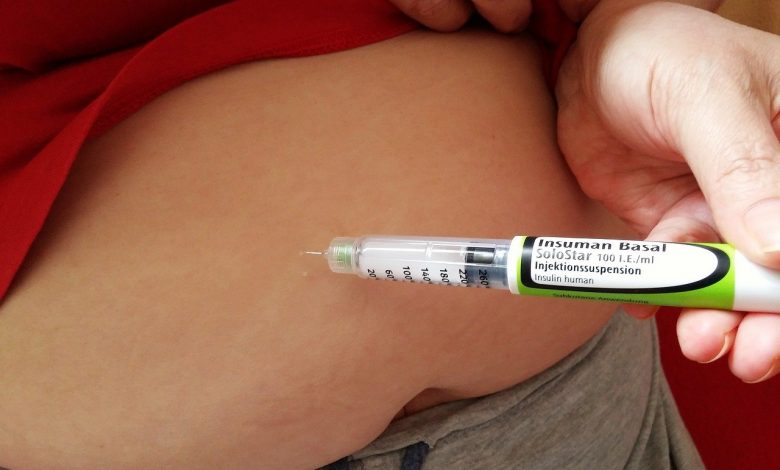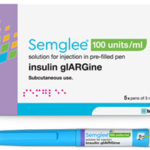How to Administer Human Insulin

Human insulin is used to control blood sugar in people who have type 1 diabetes (a condition in which the body does not make insulin and therefore cannot control the amount of sugar in the blood) or in people who have type 2 diabetes (a condition in which the blood sugar is too high because the body does not produce or use insulin normally) that cannot be controlled with oral medications alone.
The type of insulin you’ll be prescribed will vary depending on things like:
- your age
- your activity level
- how long it takes your body to absorb insulin
- how long insulin stays active in your system
| Insulin type | Onset | When it peaks in your system | Duration | When taken |
| Ultra-rapid acting | 2 to 15 min | 30-60 min | 4 hours | Taken with meals, usually with the first bite of a meal. Commonly used along with long-acting insulin. |
| Rapid-acting | 15 min | 1 hour | 2 to 4 hours | Taken with meals, typically right before a meal. Commonly used along with longer-acting insulin. |
| Rapid-acting inhaled | 10 to 15 min | 30 min | 3 hours | Taken with meals, typically right before a meal. Commonly used with injectable long-acting insulin. |
| Regular or short-acting | 30 min | 2 to 3 hours | 3 to 6 hours | Taken with meals, typically 30 to 60 minutes before a meal. |
| Intermediate acting | 2 to 4 hours | 4 to 12 hours | 12 to 18 hours | Taken once or twice a day. Covers your insulin needs for half a day or overnight. Commonly used with rapid- or short-acting insulin. |
| Long-acting | 2 hours | doesn’t peak | up to 24 hours | Taken once a day. Can be used with rapid- or short-acting insulin if needed. |
| Ulta-long acting | 6 hours | doesn’t peak | 36 hours or more | Taken once a day. Can be used with rapid- or short-acting insulin if needed. |
| Premixed | 5 to 60 min | varied peaks | 10 to 16 hours | Taken twice a day, commonly 10 to 30 minutes before breakfast and dinner. This type is a combination of intermediate- and short-acting insulin. |
Human insulin is in a class of medications called hormones. Human insulin is used to take the place of insulin that is normally produced by the body. It works by helping move sugar from the blood into other body tissues where it is used for energy. It also stops the liver from producing more sugar. All of the types of insulin that are available work in this way. The types of insulin differ only in how quickly they begin to work and how long they continue to control blood sugar.
What are the different ways to take insulin?
The way you take insulin may depend on your lifestyle, insurance plan, and preferences. You may decide that needles are not for you and prefer a different method. Talk with your doctor about the options and which is best for you. Most people with diabetes use a needle and syringe, pen, or insulin pump. Inhalers, injection ports, and jet injectors are less common.
Needle and syringe
You’ll give yourself insulin shots using a needle and syringe. You will draw up your dose of insulin from the vial, or bottle, into the syringe. Insulin works fastest when you inject it in your belly, but you should rotate spots where you inject insulin. Other injection spots include your thigh, buttocks, or upper arm. Some people with diabetes who take insulin need two to four shots a day to reach their blood glucose targets. Others can take a single shot.
Insulin shots involve drawing insulin from a vial into a syringe and then injecting it under your skin.
Pen
An insulin pen looks like a pen but has a needle for its point. Some insulin pens come filled with insulin and are disposable. Others have room for an insulin cartridge that you insert and then replace after use. Insulin pens cost more than needles and syringes but many people find them easier to use.
Pump
An insulin pump is a small machine that gives you small, steady doses of insulin throughout the day. You wear one type of pump outside your body on a belt or in a pocket or pouch. The insulin pump connects to a small plastic tube and a very small needle. You insert the needle under your skin and it stays in place for several days. Insulin then pumps from the machine through the tube into your body 24 hours a day. You also can give yourself doses of insulin through the pump at mealtimes. Another type of pump has no tubes and attaches directly to your skin, such as a self-adhesive pod.
Inhaler
Another way to take insulin is by breathing powdered insulin from an inhaler device into your mouth. The insulin goes into your lungs and moves quickly into your blood. Inhaled insulin is only for adults with type 1 or type 2 diabetes.
Injection port
An injection port has a short tube that you insert into the tissue beneath your skin. On the skin’s surface, an adhesive patch or dressing holds the port in place. You inject insulin through the port with a needle and syringe or an insulin pen. The port stays in place for a few days, and then you replace the port. With an injection port, you no longer puncture your skin for each shot—only when you apply a new port.
Jet injector
This device sends a fine spray of insulin into the skin at high pressure instead of using a needle to deliver the insulin.

How Human insulin should be used
Human insulin comes as a solution (liquid) and a suspension (liquid with particles that will settle on standing), To be injected subcutaneously (under the skin). Human insulin is usually injected subcutaneously several times a day, and more than one type of insulin may be needed. Your doctor will tell you which type(s) of insulin to use, how much insulin to use, and how often to inject insulin. Follow these directions carefully. Do not use more or less insulin or use it more often than prescribed by your doctor.
Human insulin (Myxredlin, Humulin R U-100, Novolin R) solution may also be injected intravenously (into a vein) by a doctor or nurse in a healthcare setting. A doctor or nurse will carefully monitor you for side effects.
Human insulin controls high blood sugar but does not cure diabetes. Continue to use human insulin even if you feel well. Do not stop using insulin without talking to your doctor. Do not switch to another brand or type of insulin or change the dose of any type of insulin you use without talking to your doctor.
Human insulin comes in vials, prefilled disposable dosing devices, and cartridges. The cartridges are designed to be placed in dosing pens. Be sure you know what type of container your insulin comes in and what other supplies, such as needles, syringes, or pens, you will need to inject your medication. Make sure that the name and letter on your insulin are exactly what your doctor prescribed.
If your human insulin comes in vials, you will need to use syringes to inject your dose. Be sure that you know whether your human insulin is U-100 or U-500 and always use a syringe marked for that type of insulin. Always use the same brand and model of needle and syringe. Ask your doctor or pharmacist if you have questions about the type of syringe you should use. Carefully read the manufacturer’s instructions to learn how to draw insulin into a syringe and inject your dose. Ask your doctor or pharmacist if you have questions about how to inject your dose.
If your human insulin comes in cartridges, you may need to buy an insulin pen separately. Talk to your doctor or pharmacist about the type of pen you should use. Carefully read the instructions that come with your pen, and ask your doctor or pharmacist to show you how to use it.
If your human insulin comes in a disposable dosing device, read the instructions that come with the device carefully. Ask your doctor or pharmacist to show you how to use the device.
Never reuse needles or syringes and never share needles, syringes, cartridges, or pens. If you are using an insulin pen, always remove the needle right after you inject your dose. Dispose of needles and syringes in a puncture-resistant container. Ask your doctor or pharmacist how to dispose of the puncture-resistant container.
Your doctor may tell you to mix two types of insulin in the same syringe. Your doctor will tell you exactly how to draw both types of insulin into the syringe. Follow these directions carefully. Always draw the same type of insulin into the syringe first, and always use the same brand of needles. Never mix more than one type of insulin in a syringe unless you are told to do so by your doctor.
Always look at your human insulin before you inject it. If you are using regular human insulin (Humulin R, Novolin R), the insulin should be as clear, colorless, and fluid as water. Do not use this type of insulin if it appears cloudy, thickened, or colored, or if it has solid particles. If you are using an NPH human insulin (Humulin N, Novolin N) or premixed insulin that contains NPH (Humulin 70/30, Novolin 70/30), the insulin should appear cloudy or milky after you mix it. Do not use these types of insulin if there are clumps in the liquid or if there are solid white particles sticking to the bottom or walls of the bottle. Do not use any type of insulin after the expiration date printed on the bottle has passed.
Some types of human insulin must be shaken or rotated to mix before use. Ask your doctor or pharmacist if the type of insulin you are using should be mixed and how you should mix it if necessary.
Talk to your doctor or pharmacist about where on your body you should inject human insulin. You can inject your human insulin into the stomach, upper arm, upper leg, or buttocks. Do not inject human insulin into muscles, scars, or moles. Use a different site for each injection, at least 1/2 inch (1.25 centimeters) away from the previous injection site but in the same general area (for example, the thigh). Use all available sites in the same general area before switching to a different area (for example, the upper arm).





